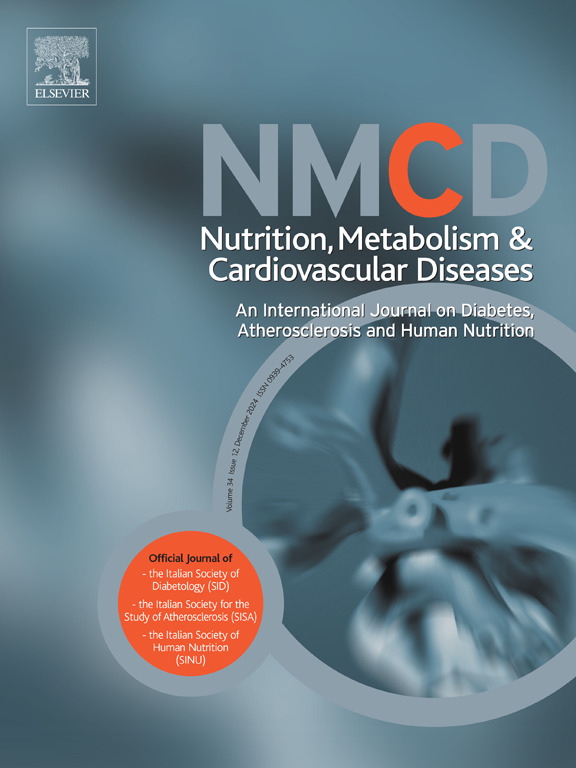Metabolomic profiles of body shapes and their associations with the risks of incident cardiovascular diseases in Chinese adults
IF 3.7
3区 医学
Q2 CARDIAC & CARDIOVASCULAR SYSTEMS
Nutrition Metabolism and Cardiovascular Diseases
Pub Date : 2025-04-04
DOI:10.1016/j.numecd.2025.104031
引用次数: 0
Abstract
Background and aims
To explore the metabolomic profiles of different body shapes, their potential similarities and differences, and their associations with the risks of incident cardiovascular diseases.
Methods and results
Plasma metabolite, body mass index (BMI), and waist-to-height ratio (WHtR) data were available in 7471 Chinese adults. We categorized body shapes into four groups by combining BMI (low: <24 kg/m2, high: ≥24 kg/m2) with WHtR (low: <0.5, high: ≥0.5). We used linear regression and enrichment analysis to characterize metabolomic profiles and elastic-net regression to construct metabolite scores for body shapes. In nested case-control studies, we explored the associations of metabolite scores with the risks of coronary heart disease, acute coronary syndrome (ACS), and stroke, including 1621, 657, and 1289 case-control pairs, respectively. Compared with low BMI and low WHtR, four shared (e.g. arginine and proline metabolism) and eight specific (e.g. glutathione metabolism) metabolite sets were identified for the other three body shapes. Metabolite scores for low BMI and high WHtR, and high BMI and low WHtR were associated with increased and decreased risks of ACS, respectively [odd ratios (95 % confidence intervals): 1.28 (1.14, 1.45) and 0.81 (0.72, 0.91)]. The metabolite score for high BMI and high WHtR was associated with increased risks of ACS, total and ischemic stroke [odd ratios (95 % confidence intervals): 1.21 (1.07, 1.37), 1.10 (1.01, 1.21), and 1.15 (1.04, 1.28)].
Conclusions
This study unveiled metabolomic profiles of different body shapes, the underlying similarities and differences, and their associations with incident cardiovascular diseases.
中国成年人体型代谢组学特征及其与心血管疾病发生风险的关系
背景和目的:探讨不同体型的代谢组学特征,它们的潜在异同,以及它们与心血管疾病发生风险的关系。方法与结果:7471名中国成年人的血浆代谢物、体重指数(BMI)和腰高比(WHtR)数据。我们通过结合BMI(低:2,高:≥24 kg/m2)和WHtR(低:)将体型分为四组。结论:本研究揭示了不同体型的代谢组学特征、潜在的相似性和差异,以及它们与心血管疾病的关联。
本文章由计算机程序翻译,如有差异,请以英文原文为准。
求助全文
约1分钟内获得全文
求助全文
来源期刊
CiteScore
6.80
自引率
2.60%
发文量
332
审稿时长
57 days
期刊介绍:
Nutrition, Metabolism & Cardiovascular Diseases is a forum designed to focus on the powerful interplay between nutritional and metabolic alterations, and cardiovascular disorders. It aims to be a highly qualified tool to help refine strategies against the nutrition-related epidemics of metabolic and cardiovascular diseases. By presenting original clinical and experimental findings, it introduces readers and authors into a rapidly developing area of clinical and preventive medicine, including also vascular biology. Of particular concern are the origins, the mechanisms and the means to prevent and control diabetes, atherosclerosis, hypertension, and other nutrition-related diseases.

 求助内容:
求助内容: 应助结果提醒方式:
应助结果提醒方式:


